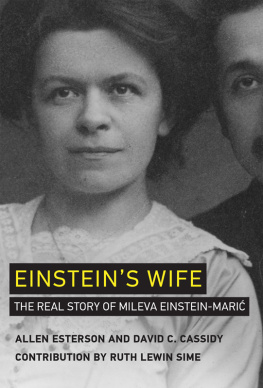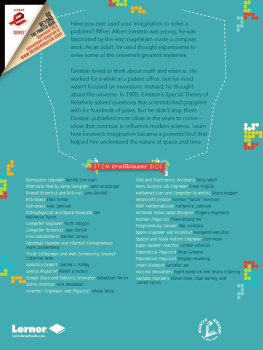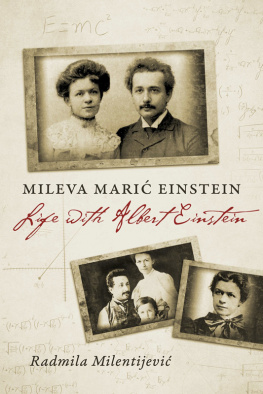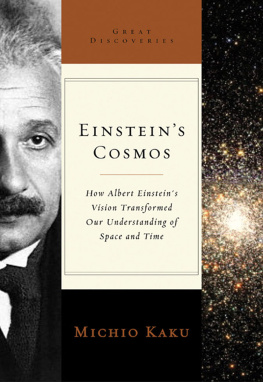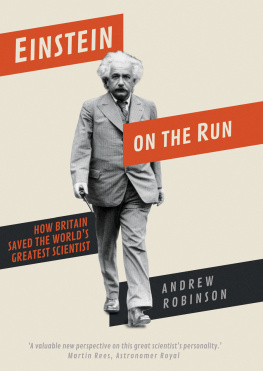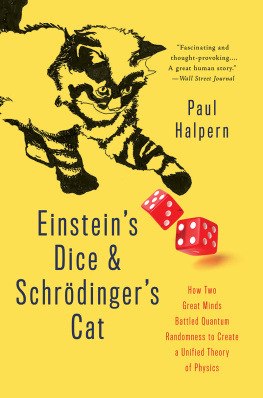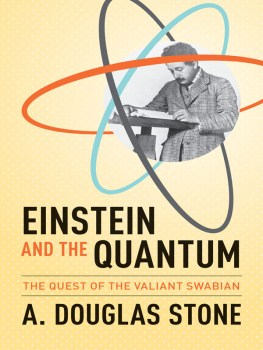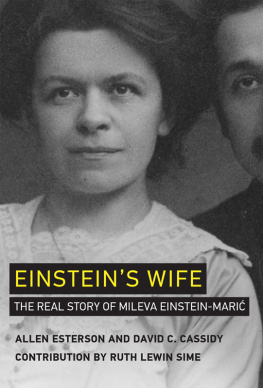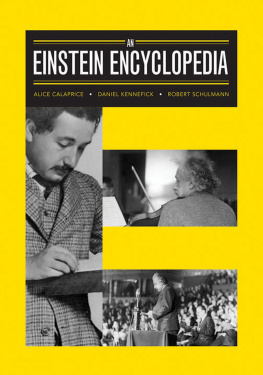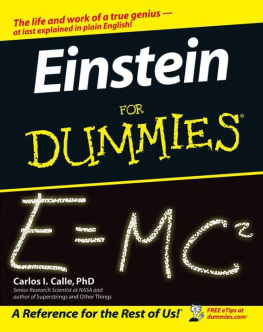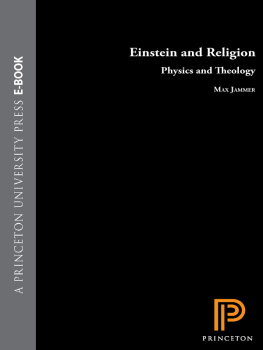EINSTEINS WIFE
THE REAL STORY OF MILEVA EINSTEIN-MARI
ALLEN ESTERSON AND DAVID C. CASSIDY
WITH A CONTRIBUTION BY RUTH LEWIN SIME
The MIT Press
Cambridge, Massachusetts
London, England
2019 Massachusetts Institute of Technology
All rights reserved. No part of this book may be reproduced in any form by any electronic or mechanical means (including photocopying, recording, or information storage and retrieval) without permission in writing from the publisher.
This book was set in Adobe Garamond Pro by Jen Jackowitz. Printed and bound in the United States of America.
Library of Congress Cataloging-in-Publication Data
Names: Esterson, Allen, 1936- author. | Cassidy, David C., 1945- author. | Sime, Ruth Lewin, 1939- author.
Title: Einstein's wife : the story of Mileva Einstein-Mari / Allen Esterson and David C. Cassidy; essay by Ruth Lewin Sime.
Other titles: Story of Mileva Einstein-Mari | Mileva Einstein-Mari
Description: Cambridge, MA : The MIT Press, [2019] | Includes bibliographical references and index.
Identifiers: LCCN 2018029638 | ISBN 9780262039611 (hardcover : alk. paper)
Subjects: LCSH: Einstein-Mari, Mileva, 1875-1948. | Einstein, Albert, 1879-1955Marriage. | Einstein, Albert, 1879-1955Family. | Women mathematiciansBiography. | Women mathematiciansSerbiaBiography. | Women mathematiciansGermanyBiography. | MathematiciansBiography. | MathematiciansSerbiaBiography. | MathematiciansGermanyBiography.
Classification: LCC QC16.E52 E88 2019 | DDC 510.92 [B] dc23 LC record available at https://lccn.loc.gov/2018029638
ISBN: 978-0-262-03961-1
eISBN 9780262352055
ePub Version 1.0
Acknowledgments
The authors express their great appreciation to Alberto A. Martnez and an anonymous referee for their careful reading of the manuscript and for their excellent suggestions.
We wish sincerely to thank Ruth Lewin Sime for her contribution and Gerald Holton for his advice.
, and to Boidar Kerekovi of the State Archive for permission to publish them.
For their generous assistance in helping us locate and obtain photographs and for their permission to publish them we are very grateful to Or Orith Burla Barnea of The Albert Einstein Archives at The Hebrew University of Jerusalem; to Michael Simonson of the Leo Baeck Institute, New York; to the Niels Bohr Library and Archives, American Institute of Physics, College Park, Maryland; and to the ETH Library Zurich, Photo Archive.
The authors wish to thank Katie Helke and the staff of MIT Press for their expert work and care in the publication of this book.
In addition to the above, Allen Esterson would like to thank David C. Cassidy for his work in getting my chapters into publishable form as the first stage in the production of the final draft.
Abbreviations
After her marriage Mileva Mari took the name Mileva Einstein-Mari. Thus, before, during, and after her marriage her last name ended in Mari. Solely for simplicity, we use Mari when referring to her by last name.
We use the following abbreviations throughout:
| AAAS | American Association for the Advancement of Science |
| CPAE | Einstein 1987ff. The Collected Papers of Albert Einstein, followed by volume number and document or page number. All of the published volumes and their English translations are online at http://einsteinpapers.press.princeton.edu/. |
| E-M | Einstein and Mari . The Love Letters. Many of the letters from and to Mileva Mari were undated or only partially dated. Editors of the volume assigned tentative dates to this correspondence; we have incorporated these dates into the text to ensure chronological clarity, or on some occasions included them in the parenthetical references. |
| ETH | Eidgenssische Technische Hochschule (Swiss Federal Institute of Technology), until 1911 the Swis Polytechnic Institute, Zurich. |
| M-KS | Popovi . |
| [ref in original] | When relevant we include in brackets the references cited by other authors we quote, using a format that corresponds to references in our bibliography. |
| T-G | Trbuhovi-Gjuri 1969ff, biography of Mileva Einstein-Mari, followed by year(s) of the edition(s) cited. The 1982 and 1983 editions are identical, as are the 1988 and 1993 editions. References to both the 1983 and 1988 editions are given because new material added to the latter edition caused the pagination to change. |
| T-P | Troemel-Ploetz , followed by page numbers. |
Introduction
Who was the real Mileva Einstein-Mari, the wife of the famed physicist Albert Einstein? Trained alongside Einstein in physics and mathematics, what role did she play, if any, in the famous papers of her husband, which transformed contemporary physics? Was she an unsung contributor or even a co-author, a sounding board, the top fiddle, a glorified assistant, an unglorified housewife, the one who made it all possible?
What does it even matter? It matters, of course, because Einstein's work and his theories of relativity, quantum theory, and atomic theory formed the foundations of contemporary physics. Without the true story of what really happenedhow these fundamental theories came aboutwe cannot fully understand their historical significance. Moreover, we cannot bestow credit where credit is due for these achievements, especially when we recognize how often the contributions of women scientists, especially the scientific spouses and partners of celebrated male scientists, are overlooked, forgotten, and even suppressed.
Much has been written over the past decades in support of one or more of the above perspectives on Mileva Einstein-Mari, often with fervent certitude This book is an excursion into these heavy waters, a journey guided by the historical urge to get it rightor at least to get as close as possible to rightfor the sake of Mileva and Albert, and for the sake of the history of contemporary physics. Such a journey becomes all the more important in an era of deliberate falsehoods, fake news, and alternate facts. The ballast of mounting documentary evidence that has become available during the past decades about these two extraordinary people and their work and activities keeps this ship on course.
It is well known that Albert Einstein, the world-famous scientist declared the person of the century by Time magazine, was married. But until the 1990s, few people knew that he had two wives, the first of whom was trained in mathematics and physics. Einstein's nonscientific second wife, Elsa, did become widely known, especially in the United States, when she accompanied her husband on several well-publicized visits during the 1920s, then settled with him in Princeton in 1933 (she died three years later). The two had married in 1919, the same year that the first public confirmation of Einstein's theory of general relativity, one of the greatest achievements of the twentieth century, brought him worldwide fame.
But it was his first wife, Mileva Einstein-Mari (approximately pronounced Mar-itch), who accompanied and supported him intellectually and emotionally throughout the difficult early years of his rise from a beginning physics student in 1896 to the top of his profession by 1914. Little was known about her or his children with herand there was little interest in finding outuntil the discovery in 1986 of her correspondence with Einstein brought Mileva Einstein-Mari to widespread public attention. The letters had been in the possession of the Einsteins first son, Hans Albert Einstein, and his family in Berkeley, California.
The story of Mileva Einstein-Mari encompasses many facets of great human and scientific interest related to the struggle of women in science as revealed by observing one woman's struggle to realize her dreams for a scientific career and examining a married couple's scientific and personal partnership that unfortunately did not succeed.
Next page
